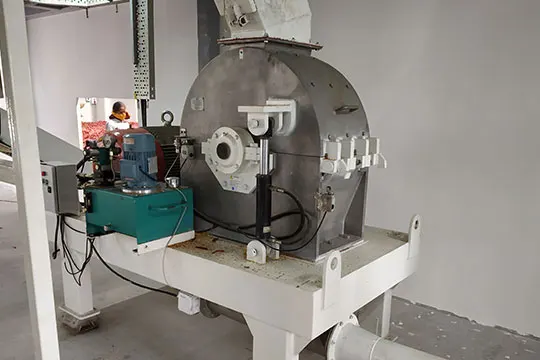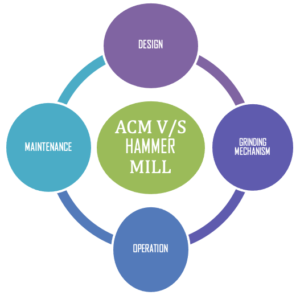Choosing Between an Air Classifying Mill and a Hammer Mill: A Complete Guide

Air Classifying Mill
Introduction
Size reduction is an important unit operation in the chemical, power, mineral, metallurgical, and pharmaceutical industries. While many sources explain the fundamentals of material size reduction, few teach how to select and size the right type of mill, operate it efficiently, and maintain it. There are numerous types of grinding mills. This article focuses on two widely used types: the hammer mill and the air classifying mill (ACM). Hammer mills are often used for general-purpose grinding, producing finished product particle sizes from millimeters down to tens of microns. The ACM is primarily used for superfine grinding and creates a uniform particle-size distribution down to a few microns. Understanding each mill’s grinding mechanisms and operating philosophies will help us compare the two.
A Quick Comparison Between Air Classifying Mill & Hammer Mill


| ACM | Hammer Mill |
|---|---|
| Air Classifying Mill (ACM) integrates grinding, classifying, conveying, and collecting to achieve ultra-fine grinding (down to ~2 µm*, product-dependent). | Hammer mill grinds by impact, with sieving and collection. Product can be collected at the bottom (gravity) or via a pulsed jet collector for dust-free operation. |
| Grinding occurs as product meets a pin- or bar-type rotor disc. Reduced particles are entrained by the airstream entering below the rotor, carried up between the inner wall and shroud ring with baffles, deflected by an air-dispersion ring to the separator. Acceptable product is collected by a high-efficiency bag filter; oversize returns to the rotor for additional grinding. | Consists of a series of hammers hinged on a central shaft within a rigid metal case. Size reduction occurs by impact. Material fed into the chamber is struck by hammers rotating at high speed and then passes through screens. |
| Can be designed for hygroscopic, heat-sensitive, or explosive materials using inert gas/closed-loop systems with dry, chilled air. | Best suited to free-flowing, non-hygroscopic, non-heat-sensitive, and non-explosive materials to produce consistent particle-size distributions. |
Parameters of Comparison – ACM & Hammer Mill
Comparing any machine depends on the following parameters:

Design:
The Air Classifying Mill (ACM) offers flexible design options and can be tailored to specific applications. It supports temperature-controlled grinding, inert milling, and cryogenic milling. The clam-shell body provides effortless access to the grinding chamber. Pressure-resistant piping, disposable liners, classifier wheels, and grinding pins/bars/hammers are available.
In contrast, hammer mills use variable hammers and can deliver fine finished products. Shaft speed is a key design aspect; a frequency converter is often used to regulate RPM. Hammer mills can incorporate provisions to intercept foreign bodies (e.g., metal particles).
Operation:
In an ACM, product enters the grinding zone via feed screw or pneumatic conveying through a rotary airlock. Particles break on impact and are swept to the internal classifier rotating with the rotor disc. Particles circulate until they meet the cut point, then are collected (e.g., cyclone/bag filter).
Hammer mill operation is straightforward: material enters a feed hopper, moves to the crushing chamber, and is repeatedly impacted by swinging or fixed hammers until it passes through the selected screen. ACMs typically require a cyclone, bag filter, fan arrangement, and compressed air; standalone hammer mills generally do not.
Grinding Mechanism:
The ACM uses centrifugal force and controlled airflow to transport and classify particles continuously until the target size is achieved.
In a hammer mill, a rotor with hammers mounted on a horizontal or vertical shaft impacts material; the screen aperture dictates the final size. In ACMs, particle size is controlled by the classifier cut point; in hammer mills, by the screen selection.
Maintenance:
The ACM’s design enables quick maintenance: components such as the classifier, liner plate, shroud ring, and rotor plate can be removed easily. Hinged top nuts/fly nuts further simplify access.
Hammer mills require routine maintenance. Screens, pins, and hammers are wear parts and need periodic replacement. Long-term items include flow directors, wear liners, regrind chambers, screen carriages, bearings, and couplings.
Key Takeaway
Several parameters must be evaluated before selecting a mill: required annual capacity, continuous vs batch operation, and upstream/downstream processes. A thorough characterization of the feed material is essential to identify the right mill for the job.
If your application is limited to grinding material to a required fineness and the material is non-hygroscopic, non-explosive, and not heat-generating, a hammer mill is often the best choice.
If you expect to process different materials requiring varied fineness, including hygroscopic, heat-sensitive, or explosive materials, a versatile mill like the ACM is generally the better long-term solution.




